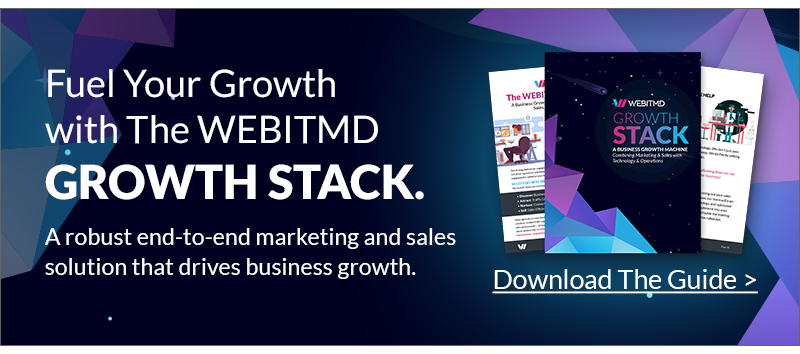One of the main reasons why businesses invest in a growth marketing agency is for the single fact that their internal team is not properly trained to recognize what types of data need to be tracked, how to track and monitor said data, and why it matters to your bottom line.
In part one of this two-part sales blog, we looked at what various metrics growth marketing agencies track, and this article will pick up where we left off by covering pipeline sales and lead generation metrics, as well as inbound-based outreach metrics, sales channel metrics, and sales productivity metrics.
Pipeline Sales Metrics
Being able to gauge the health of your sales pipeline is critical to maximizing your revenue. Pipeline sales metrics help you understand what’s working well in your holistic sales process, and what isn’t. The best growth marketing agencies will work with your internal team to look at these metrics:
- Average sales cycle length
- Total closed opportunities by month or quarter, by teams or individuals
- Total open opportunities by month or quarter, by teams or individuals
- Total value of sales by month or quarter, by teams or individuals
- Weighted value of the pipeline by month or quarter, by teams or individuals
- Win rate by teams or individuals
- Average contract value (ACV)
- Conversion rate from every sales funnel stage by teams or individuals
This data is critical to track because it can provide a basis for optimizing the sales process, and the various marketing campaigns and strategies responsible for driving traffic and converting leads into sales.
Lead Generation Sales Metrics
One of the most frequently tracked set of metrics that growth marketing agencies engage with their client’s internal teams include data that encompasses lead generation sales. This lets your C-Suite and growth marketing agency understand how well the sales team is prospecting, and how the investment in growth marketing pays off in ROI. These metrics include:
- Customer Acquisition Cost (CAC)
- Percentage of dropped leads
- Percentage of followed-up leads
- Percentage of followed-up leads within target time ranges (for example, 10 hours)
- Percentage of qualified leads
- Volume and frequency of pipeline receiving new opportunities
- Average lead response team
Inbound Marketing and Outreach Metrics
This is where growth marketing agencies really shine, because some of these metrics won’t be important to your business. Now only is a growth marketing stack a custom strategy that fits your unique needs, the metrics worth tracking are also customized to your business. But all of that aside, here are some common Inbound and outreach metrics tracked by top organizations and their growth marketing agency:
Phone Sales Metrics –
- Number of call-backs
- Percentage of prospects funneled on to the next step in the buyer’s journey
- Engagement rate (downloads, webinar attendance, videos plays, clicks, etc,)
- Percentage of leads that convert
Email Sales Metrics –
- Response rate
- Open rate
- Engagement rate
- Percentage of people that move on to the next stage in the buyer’s journey
Ultimately, the metrics worth tracking will be based on your individual sales process, the strategy your growth marketing agency designs. And the methodology. In other words, if your reps exclusively hone in on prospects they meet at trade shows and seminars, then the average “contact to meeting” rate would offer a better reflection of the team’s performance than email open rates.
Channel Sales Metrics
Knowing your channel sales metrics is critical because it will help you optimize every channel’s strategy for greater sales performance. These metrics include:
- Margin
- Revenue
- Combined revenue from deals
- Number of revenue goals hit
- Average deal size
- Number of opportunities in pipeline
- Number of qualified opportunities added
- Number of new opportunities added
- Number of closed/lost and closed/won
- Average deal rate (how many days/weeks/months until the deal is closed/lost or closed/won)
- Retention rate of customers
- Average customer satisfaction score
- Average upsell and cross-sell rate
- Number of new clients added
- Number of new clients lost
- Average time to locate, onboard, and train (if applicable)
Understanding how various channels play into the sales process will allow your team to work with the growth marketing agency to redirect time and resources to the channels that bring in the most customers that show the greatest growth, while potentially giving insight if some channels should be removed, or new ones added.
Sales Productivity Metrics
Also known as the rate at which your sales team hits their revenue targets, sales productivity offers a set of metrics not to be ignored. This is all based around the fact that the shorter the time it takes for your sales team to meet their quota, the higher your sales productivity will be. In order to determine how productive your sales team is, track these metrics and report them to your growth marketing agency’s sales enablement expert:
- Average time it takes to create content
- Average time spent on manual data entry
- Percentage of marketing collateral used by the sales team
- Average number of daily sales technology platforms and tools being utilized (or not utilized)
- Percentage of high-quality leads that are followed-up
- Average amount of time spent on selling activities
- Average turnover rate percentage
- Average cost to replace sales team members according to role
- Average tenure members in the company
- Sales ramp-up (average time it takes to train a new team member until they are fully efficient)
These metrics can help growth marketing agencies and their clients made more accurate sales predictions, as well as make smarter hiring and firing decisions. And growth marketing teams can calculate all of this in a variety of methods. WEBITMD uses a robust CRM to customize and program to automatically calculate meantime to 100 percent of the quota attainment that is used to set ramp. For example, if the average sales team member takes three months to hit 100 percent of the quota, then ramp-up time would be three months. This may sound simplistic, but it neglects the fact that new sales team members almost always take on existing accounts or prospects thus giving them a head start. Furthermore, a sales team member who hits 94 percent of their quota could be fully ramped, but this formula would not accurately include them until they hit 100 percent.
This is exactly why WEBITMD offers an approach that factors in training, prior experience, and sales cycle lengths. In other words, Ramp = average length of sales cycle + amount of sales training time spent + Y (Y = the salesperson’s overall experience). The more experience they have, the smaller this number will be.
Here is an example: You have a highly experienced rep. Let’s assume training takes 14 days and your average sales cycle is four weeks. In this case Ramp = 14 days + 28 days + 8 days. According to this formula (credited to Somen Mondal) the salesperson would require 50 days to reach maximum efficiency.
CRM technology adaptation and the number of sales people using the tool also play a factor into this, and when you invest in a growth marketing agency, all the right people get trained on using the CRM and its many features that play into everything from monitoring lead flows, qualifying leads, marketing automation, and winning deals.
Discover the WEBITMD Growth Stack and Our Multi-Channel Approach Centered Around Sales Enablement!
Leading indicators and CRM use are other areas vital to tracking the right metrics to help you hit your sales goals? Want to learn more? Download our FREE guide on the WEBITMD Growth Stack, and reach out to our team. We would love to learn about your sales process, customers, and products. Together, we can find the best approach to helping you hit your revenue goals.










.jpg)



.jpg)





![5 Reports to Elevate Your HubSpot Sales Dashboard [+ Examples]](https://blog.webitmd.com/hs-fs/hubfs/Imported_Blog_Media/6-winning-examples-of-a-hubspot-sales-dashboard-2.png?width=767&name=6-winning-examples-of-a-hubspot-sales-dashboard-2.png)